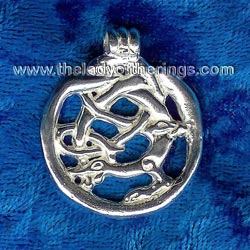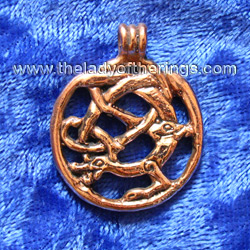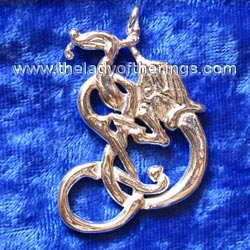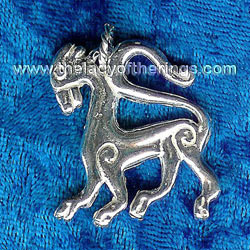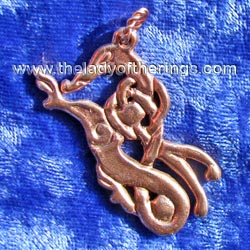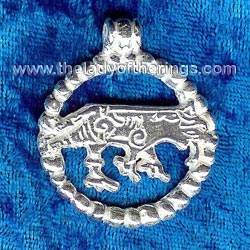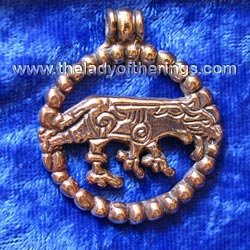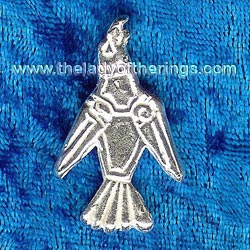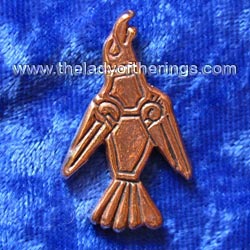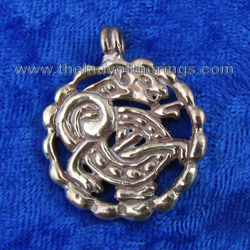The Lady of the Rings
Viking Animals
The pieces displayed on this page are in stock (unless specified otherwise) and directly available. If the stock is empty, a reedition is likely. Please note that some of these jewels are ones-of-a-kind and may not be reedited!
These jewels are inspired by carvings on runestones, or illustrated stones. Although these pieces are not reproductions of historical jewels, they are perfect accessories for connoisseurs, history fans and viking style lovers.
Uppland Runic Dragon
This piece is inspired by a pattern carved on a runestone in Uppland, Sweden.
Its style is definitely Urnes
27 mm diameter, 2.5 mm thick
Hole's minimal diameter 3 mm
Skillsta Dragon
In the nordic myths, the dragon is powerful and greedy. Think of Fáfnir, who murdered his kin for Andvari's treasure, and who turned into a dragon to keep it. Or Níðhöggr, constantly gnawing at Yggdrasill's roots. You can also find a protective force within Jörmungandr, as the sea-dragon keeps the earth in shape, but it is also a chaotic entity.
This winged dragon is an unusual representation of the classic viking dragon. It is inspired from the Skillsta Uppland, Sweden) runestone, save for the head (missing on the stone), created and placed differently on this jewel. The graphic style is Urnes.
This pendant is wearable on both sides.
32 mm wide, 50 mm long, 3.5 mm thick
Hole's minimal diameter 3 mm
Tjursåker Beast
This kind of beast is pretty common on runestones. It is typical of the Urnes style.
This pendant is an adaptation of a design found on Tjursåker stone, Sweden, and dated XIth century.
This pendant is wearable on both sides.
30 mm wide, 38 mm long, 3.5 mm thick
The length includes a 5 mm ring
Lingsberg Horse
In the nordic myths, the horse is considered the carrier of souls.
It also holds a magic side : people used its head to cast a spell of bad reputation on their foes. But the horse is also imbued of a sacred aura and takes an active part in fertility rites.
This beast, the shape of which is horse-like, is engraved on the Lingsberg runestone, Uppland, Sweden.
With its Urnes graphic style, the stone dates back from the second quarter of XIth century.
This pendant is wearable on both sides.
25 mm wide, 50 mm long, 3.5 mm thick
Hole's minimal diameter 5 mm
Hunnestad Wolf
Often associated with the forces of chaos, the wolf already fascinated the vikings. As Fenrir son of Loki, as an eater of the sun and moon or a witch's steed, its presence haunts the nordic mythology.
This Ringerike-style jewel is inspired from a carving on one of the Hunnestad monument stones, Scania, Sweden, 985-1035.
36 mm wide, 42 mm long, 3.5 mm thick
Hole's minimal diameter 3 mm
Alstad Raven
The raven was highly estimated during the Viking Age. Bird of Odin, it brought the god news of the worlds. As a mediator between the world of humans and the one of the gods, it is only natural that the raven finds its place on runic monuments.
This pendant is an adaptation of a carving found on Alstad stone, Norway, dated around 1000 CE. Its design belongs to a transitional style between Mammen and Ringerike.
21 mm wide, 35 mm long, 3mm loop on the backside
Freyja's Cat
Animal associated with Freyja, the cat does not take a big part in the norse myths, except for the fact that the goddess of love, seduction, magic and war used a chariot pulled by a couple of cats.
This pendant is an original creation in a Jellinge/Mammen viking style.
26 mm diameter, 3 mm ring.

